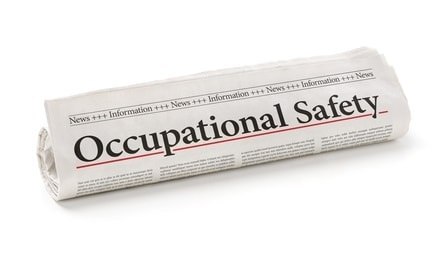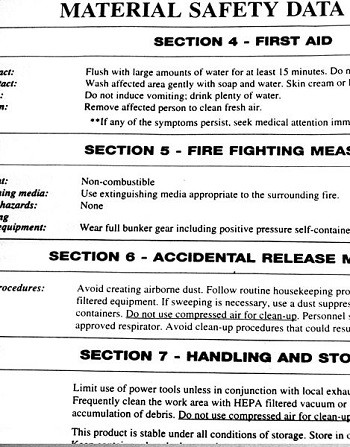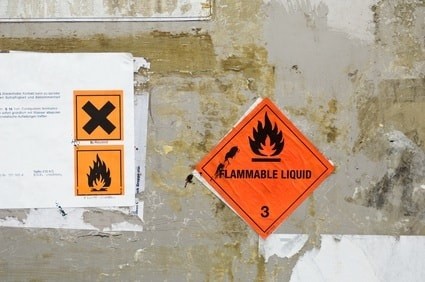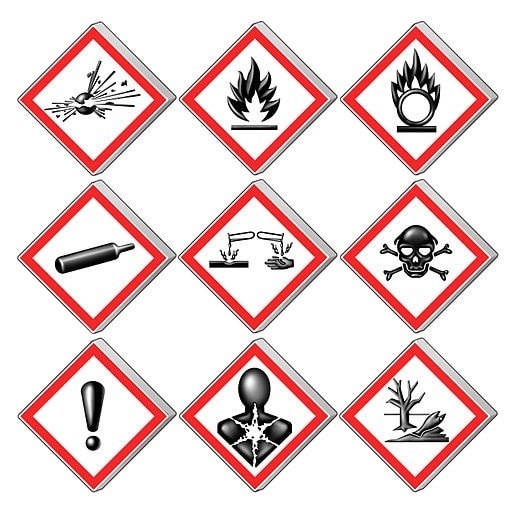Hazard communication standards impact 43 million workers and five million businesses in the United States who produce or handle hazardous chemicals. The goal of hazard communication standards is to reduce workplace injuries and illnesses resulting from exposure to hazardous materials. Recently, the HCS was updated to align these standards with international GHS standards, ensuring greater consistency in hazard communications for chemicals transferred internationally. 
We’ve created this guide to provide a comprehensive overview of HAZCOM, including the requirements set forth by the HCS and GHS, roles and responsibilities for the various entities involved in the manufacture, import, or handling of hazardous chemicals, and specific labeling requirements for hazardous chemicals.
In this guide, we’ll discuss:

Image via Wikipedia
Hazard communication standards (HCS) are a set of guidelines and requirements, issued by the Occupational Safety and Health Administration (OSHA), related to the identification of hazardous chemicals, the health and safety hazards associated with those hazardous materials, and the appropriate safety measures that reduce the risk of illness and injury when handling these materials. HCS was first issued on November 25, 1983, and since that time, safety has dramatically increased in the workplace.
According to OSHA, 25 states, as well as Puerto Rico and the U.S. Virgin Islands, have adopted OSHA-approved State Plans, and they have adopted their own standards and enforcement policies that are largely identical to federal OSHA standards. Some states, however, have adopted different standards or may utilize different enforcement policies. Twenty-one states and one U.S. territory cover private and state and local government workplaces, while the remaining five states and one U.S. territory have implemented plans that apply only to state and local government workers. For this reason, it’s important for manufacturers, importers, and employers that handle hazardous chemicals to be familiar not only with the federal OSHA standards but also any applicable state requirements and enforcement policies to ensure compliance on both the state and federal level.
Most recently, OSHA issued changes to the HCS in alignment with the Globally Harmonized System of Classification and Labelling of Chemicals (GHS). Aligning the HCS with GHS allows for a standardized approach to hazardous chemical classification, labeling, and safety data – on an international level, a logical step in today’s global marketplace. Employers were required to implement workplace labeling and hazard communication procedures to comply with the final rule by June 1, 2016.
The updated HCS includes the following:
The HCS falls under (29 CFR 1910), Subpart Z, Toxic and hazardous substances. The following appendices provide important information on both mandatory and non-mandatory elements of HCS:
In addition to these requirements, employers must develop and implement a written hazard communication program. This program should include:
A written hazard communication program must be available to all employees and any designated representatives of employees, as well as the Assistant Secretary of Labor for Occupational Safety and Health and the Director of the National Institute for Occupational Safety and Health (NIOSH). OSHA provides a draft model training program here.
Safety data sheets are now required to contain specific information, including 16 specified sections:

Image via Wikimedia Commons
SDSs contain more detailed information than what appears on HAZCOM labels. As such, they must be readily accessible by employees for any and all hazardous chemicals used in the workplace. Additionally, they should include information about the data that was used in determining the hazards.
Generally, suppliers are responsible for creating safety data sheets and providing them downstream to customers. Manufacturers, importers, and distributors should supply SDSs to employers that are end users of chemicals, and these end users are not liable for the accuracy of the information contained in an SDS, provided that it was accepted from the manufacturer, distributor, or importer in good faith – in other words, the SDS contains no blank spaces and does not contain obvious inaccuracies. If such inaccuracies or missing information is identified by end users, it should be reported to the chemical manufacturer or distributor. One exception to this rule is when an employer opts to conduct their own hazard classification, in which case the employer is liable for the accuracy of the SDS.
The HCS relies heavily on labels and safety data sheets to convey important hazard information and safety precautions to workers who come in contact with or handle hazardous materials in the workplace. Because labels and SDSs are often the primary means of communication (along with employee training), properly following the label requirements and making SDSs readily accessible is paramount to creating a safe workplace.
The label requirements for hazardous chemicals has changed under the new, GHS-aligned HCS rule. Labels are now required to contain certain elements for each hazard class and category, including:

There are no formal, standardized requirements on the appearance of these labels, nor is there a particular format that employers must use. The only restrictions on aesthetics and format are that they cannot detract from the required information or contradict the required information in any way. In addition to containing the required elements and information, labels:
All information on labels must remain legible, meaning that employers must take steps to ensure that the information does not fade or otherwise become defaced. Employers should opt for durable custom labels or compliance tags, such as labels constructed of Metalphoto® photosensitive anodized aluminum, to eliminate the cost of replacing labels that have become defaced. Metalphoto labels include a photographic image sealed inside anodized aluminum, offering excellent resistance to degradation from exposure to sunlight, as well as corrosion, abrasion, extreme hot or cold temperatures, and even exposure to chemicals –an important consideration for HAZCOM labels. Employers that opt for durable label solutions not only save on the cost of label replacements but are also able to devote more time and resources to other HAZCOM compliance demands.
For in-plant labeling, OSHA offers a flexible approach for workplaces. Employers are able to create their own labeling system, or continue to use their existing labeling system, provided that labels contain all of the required information and elements.
Employers may also use other written communication materials, such as signs, placards, process sheets, batch tickets, or operating procedures instead of labeling individual stationary process containers. However, employers using this alternative method must ensure that it identifies the containers that these written communications apply to. Additionally, written communication materials must contain the information required on labels under 29 CFR 1910.1200 (f)(6). Finally, written materials must be readily accessible to all employees in a work area throughout their shifts.
Labels on shipped containers must contain all information and elements required under 29 CFR 1910.1200(f)(1)). Labels must be affixed to, attached to, or printed on either the immediate container of a hazardous chemical or to outside packaging.

Image via Wikimedia Commons
Pictograms are an important component of hazard communication labels, providing a visual representation of the hazards associated with a chemical to readily alert anyone handling hazardous materials of the risks. As mentioned, there are a total of nine GHS pictograms, eight of which are required by OSHA. These pictograms fall into three categories: chemical risk, health risk, and environmental risk:
Chemical Risk Pictograms:
Health Risk Pictograms:
Environmental Risk Pictograms:
While many pictogram symbols are shared by the transportation industry, OSHA pictograms do not replace the U.S. Department of Transportation (DOT) pictograms that are required for transporting chemicals (including drums, totes, tanks, and other containers). DOT labels must be placed on the exterior of a shipped container and must meet requirements in 49 CFR 172, Subpart E. In some cases of international trade, both DOT and HCS pictograms are required on labels, even when the pictograms are the same. (OSHA plans to revise Appendix C.2.3.3. to better address this issue.) The DOT diamond label is required on outside shipping containers for all hazardous chemicals, while chemicals inside smaller containers inside the outside shipping container require only OSHA pictograms.
Hazard communication standards place certain responsibilities on different types of entities that are involved in the manufacture, handling, or use of hazardous chemicals.

Manufacturers and importers of hazardous chemicals are responsible for determining the hazards associated with each material. They are required to evaluate available scientific evidence related to the potential hazards of the chemicals they manufacture or import, and then communicate this information to employees as well as any other entities that distribute or use the products. Downstream employers rely on the evaluations conducted and information provided by chemical manufacturers and importers to establish the hazards of the chemicals they use.
Manufacturers, importers, and distributors, as well as any employers that evaluate hazards are responsible for the quality of hazard determinations they perform. All chemicals must be evaluated for the potential to cause adverse health effects, as well as the potential for physical hazards, such as flammability. All chemicals listed in 29 CFR 1910, Subpart Z, Toxic and Hazardous Substances, Occupational Safety and Health Administration (OSHA) should be deemed hazardous in all circumstances, as well as all chemicals listed in Threshold Limit Values for Chemical Substances and Physical Agents in the Work Environment, American Conference of Governmental Industrial Hygienists (ACGIH).
These entities are responsible for communicating hazard information and all associated protective measures downstream through the supply chain – to their customers – through the use of labels and material safety data sheets.
Companies that use hazardous chemicals in the workplace have several responsibilities. These include identifying and listing the hazardous chemicals in the workplace, obtaining SDSs and labels for hazardous chemicals (if labels are not provided by the manufacturer, importer, or distributor), develop and implement a written hazard communication program (including labels, SDSs, employee training, and communicating hazard information to workers through labels, SDSs, and training programs.
Employers must ensure that labels remain legible – and that the required information does not become defaced (faded, washed off, etc.) or removed. If labels become defaced, employers are responsible for replacing them; however, employers are not responsible for updating labels on shipped containers. If an employer becomes aware of newly-identified hazards that are not addressed on the current label, they must ensure that workers are informed and aware of these hazards. If hazardous chemicals are transferred to a portable container intended only for immediate use by the employee who transferred the chemical, a label for the portable container is not required.
Employers do have the option to use additional instructional symbols that are not included in HCS label requirements, such as a symbol depicting a person wearing goggles to inform workers that goggles should be worn when handling the chemical. Environmental pictograms and PPE pictograms from the HMIS are also allowable.
Employers are also able to continue using National Fire Protection Association (NFPA) diamonds or follow HMIS requirements for workplace labels, provided that they are consistent with HCS requirements and that workers have immediate access to the information. Employers that opt to utilize one of these alternative rating systems must ensure that workers are adequately trained and have a complete understanding of the hazards of the chemicals they come in contact with.
When it comes to Hazard Communication Standards compliance, the best resource is the source itself: OSHA. The Occupational Safety and Health Administration offers a few clear tips to ensure compliance:
Employers should have a clear understanding of their responsibilities under HCS and implement policies and procedures to ensure that these responsibilities are met. Implement procedures to ensure that safety data sheets are readily accessible for all chemicals in your database, and request any missing SDSs from suppliers. It’s also helpful to perform a periodic HAZCOM safety audit to identify any compliance concerns.
When it comes to meeting labeling requirements, work with an established label producer offering durable label options designed to withstand the elements and other harsh conditions to ensure readability throughout the usable lifespan of your chemical containers. Some label manufacturers are experienced in producing GHS-compliant labels, providing an added layer of assurance that your labels meet all requirements.
For more information on hazard communication standards and compliance requirements, visit the following resources:
Our sales engineers are experts in automatic asset tracking, tagging and identification,a nd can answer all your questions. Get in touch now.
Lets Talk ›